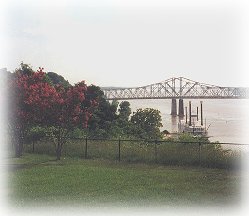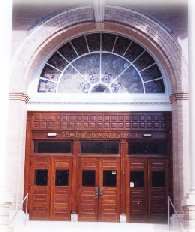
 The beautiful city of Natchez is situated 200 feet above the Mississippi River on the highest promontory north of the Gulf of Mexico. It is the oldest civilized settlement on the river. Inhabited for centuries by prehistoric indians and later by the Natchez indians, it was settled first by the French in 1716, then claimed by the British in 1763 and the Spanish in 1779. In 1798 Natchez became the capital of the new Mississippi Territory, and in 1817 became the first capital of the new state of Mississippi.
The beautiful city of Natchez is situated 200 feet above the Mississippi River on the highest promontory north of the Gulf of Mexico. It is the oldest civilized settlement on the river. Inhabited for centuries by prehistoric indians and later by the Natchez indians, it was settled first by the French in 1716, then claimed by the British in 1763 and the Spanish in 1779. In 1798 Natchez became the capital of the new Mississippi Territory, and in 1817 became the first capital of the new state of Mississippi.
The export of cotton by steamboat enabled the citizens of Natchez to prosper in the early 1800's. The large number of wealthy citizens built huge mansions there. The city's Jewish population during this period of prosperity was significant, attested to by the many mansions and buildings throughout the city with Jewish connections. Congregation B'nai Israel was established in 1843 and the first temple was built in 1870. At the turn of the 20th century, approximately 150 Jewish families lived in Natchez, making it financially possible to build a synagogue.  The South's cotton crop was destroyed in 1910 by the boll weevil. This natural disaster also took its toll on the region's Jewish population. Today, less than 20 Jewish people remain in Natchez, but the beautiful Temple B'nai Israel stands as a proud testament to their legacy. 
An equally compelling legacy is the walled section of the old City Cemetery containing the graves of a large number of former Jewish residents of Natchez. Known as Jewish Hill, the section stands proudly on a bluff overlooking the river, where one can look wistfully at some scenes which have probably remained unchanged since the days of those earlier inhabitants. 
Within this walled Jewish section are what appear to be several family plots that are surrounded by beautiful wrought iron railings. Although most of the graves are old, with some of the brick foundations showing some wear, the section, on a whole, is very clean and well-kept.  Of particular interest is the grave of 7-year-old Rosalie Beekman, hit by a mortar shell while standing in front of her father's store. She was the only casualty in Natchez during the Civil War. Inscriptions on the graves are evidence that many natives of Alsace settled in the Natchez area, such as: Seymour Netter, born in Niederbronn Alsace Germany on June 11 1867, died in Fayette, Mississippi on October 30 1902; Baruch Meyer, born at Minversheim, Alsace on October 13 1835, died December 2 1887; Moses Frank, born in Soultz, Alsace, April 12 1842, died in Vidalia, Louisiana February 23 1878. [Sources for some of the information above: website and brochure published by the Museum of the Southern Jewish Experience in Utica, Mississippi; The City of Natchez website, "Historic Natchez on the Mississippi".] |
